Quantitative Hyperspectral Reflectance Imaging
Abstract
:1. Introduction
1.1. Hyperspectral imaging in various application fields
1.2. Quantitative hyperspectral imaging of documents
- Distinguishing between materials, identifying various writing substances and substrates. For example different inks, pigments or dyes exhibit different degradation effects, and therefore they require different conservation treatments. In this sense their preliminary recognition can substantially improve the risk assessment for the preservation of historic documents.
- Determining the condition of the writing, especially that of metal-gall inks, which are a very commonly used in historic writing material. This kind of ink, when exposed to certain environmental conditions, can suffer from a strong acceleration of the chemical chain reactions that begin with the moment of the ink's production. Due to the increased reaction speed and the uncertainness about quantities and purity of chemicals used in ancient times, this ink has an extremely unstable behaviour in combination with substrates on which it has been applied. Studies in this field have identified a series of specific levels of degradation which can be of help to prevent extreme damages, such as the complete destruction of the document. The goal is to use hyperspectral measurements to identify, quantify and map these degradation levels.
- Determining the condition of the substrates, which are also subject to a range of degradation effects. Environmental parameters in the storage and exhibition rooms, such as temperature, relative humidity, pollutants, and light, have a strong influence on the aging of substrates. For example, paper oxidation and hydrolysis reactions can be initiated in the internal structure of cellulose chains resulting in the yellowing and weakening of this very common substrate. In addition, there are a number of biological and semi-biological damages which can affect substrates in general, such as insects, moulds, fungi's, foxing, etc.. It is currently investigated whether the QHSI instrument is capable of detecting and quantifying such degradation effects of substrates at an early stage, when effective preventive actions can be considered.
- In addition to using the QHSI instrument for research into the various document conservation aspects, tests are also planned on using it for historic analysis such as enhancing the visibility of faint writing and drawings, distinguishing pigments and inks to test theories about the authorship and age, et cetera.
2. Measurement principles of a HSI instrument
2.1. Implementation concepts of hyperspectral data acquisition
2.1.1. Assumptions about acquired hyperspectral data
2.1.2. Mapping of data acquisition channels
2.1.3. Push-broom technique
- All spectral data belonging to a certain location on the object is recorded simultaneously, which means that is basically a snapshot of the spectral characteristics of this object location at a certain point in time. As a consequence, any distortions of the recorded spectral characteristics by spectral changes of the illumination (for example changing sun light) or of the object itself can be largely excluded.
- The on-the-flight scanning of the object is basically a continuous process, so that the total number of measured object locations can be virtually unlimited. This is of particular advantage, if the total number of object locations to be measured is considerably larger than the number of elements on the area sensor. This is certainly the case for hyperspectral measurements of the Earth surface, but this can be also the case for cultural heritage objects such as large paintings and maps that contain small details.
- As all wavelengths are recorded simultaneously by the area sensor, special provisions have to be taken to avoid or compensate any chromatic aberration of the imaging system over the entire wavelength range, in order to avoid a reduction of the spatial and spectral resolution of the system.
- The sensitivity of the area sensor normally varies considerably over the wavelength range (see Section 3.5.). However, the exposure time (and other parameters) can typically be set only globally for all sensor elements. The exposure time has to be short enough to avoid saturation of the sensor elements recording the spectral bands for which the sensor is most sensitive. This can result in underexposure of sensor elements that record other spectral bands. Therefore, the dynamic range of the sensor elements cannot be fully exploited for all spectral bands, which results in a reduction of accuracy of the hyperspectral measurement.
- The number of spectral bands is typically much smaller than the number of object locations to be recorded, whereas typical area sensors provide roughly the same number of sensor elements in both directions. In practice this means that one cannot take advantage of the high number of sensor elements in the spectral direction for a parallel data acquisition, which potentially slows down the recording of the entire HSI cube.
2.1.4. Area imaging technique
2.1.5. Filtering in the illumination and imaging light path
- Spectral filtering in the imaging light path
- Advantages
- +
- Any broadband illuminating light source (including the sun) can be used; measurement quality depends on its stability and/or the accuracy with which light power and spectrum are monitored
- +
- More compact instrument, since filters can be included in imaging unit
- +
- Suitable for large measured areas (e.g. Earth surface)
- Disadvantages
- -
- The spatial image information has to be maintained during the spectral filtering
- -
- The object is exposed to high irradiance levels since light in all spectral bands reaches the object simultaneously, possibly inducing damage
- Spectral filtering of the illuminating light
- Advantages
- +
- The object irradiance level is kept at an absolute minimum, and especially harmful wavelengths are completely suppressed (while not used for recording)
- +
- The filtering method needs not to maintain image information
- +
- Compatibility with basically any area sensor, independent of size and construction
- Disadvantage
- -
- Not suitable for large measurement areas or when external light cannot be blocked
2.1.6. Overview of data acquisition strategies
2.2 Quantitative vs qualitative hyperspectral imaging
2.2.1. Qualitative hyperspectral imaging
2.2.2. Quantitative hyperspectral imaging (QHSI)
3. QHSI instrument design
3.1 Overall instrument setup
3.2 Setup of the tunable light sources (TULIPS)
3.3 Spatial resolution and field-of-view
3.4 Lens dispersion compensation
3.5 Spectral image recording
3.6 Summary of technical specifications
3.7. Hyperspectral measurement in practice
- Step 1 –
- positioning the object: The user places the object inside the cabinet and positions it so that the FOV of the camera covers the area to be measured. Furthermore, the distance between the object and the camera has to be adjusted such that the object surface coincides with the fixed measurement plane for which the system is calibrated. The object position can be verified in a live viewing mode of the software. Once the object is positioned, the cabinet has to be closed to ensure that no external light reaches the object.
- Step 2 –
- setting the parameters: The user may set certain measurement parameters for the various spectral bands such as the exposure time and the frame-averaging, depending on the amount of reflected light from the object and the desired trade-off between measurement quality and duration. Alternatively, pre-set parameters can be used which achieve near-optimum results for most historical documents.
- Step 3 –
- the object recording: The user starts the QHSI recording by a mouse-click. The recording of all bands runs automatically and takes about 13 min for a high-quality reflectance measurement.
- Step 4 –
- the reference recording: After the recording, the object is removed and the white standard reflectance target is placed in the camera FOV. Again, the user can start the reference recording with a mouse-click and the data acquisition runs automatically taking again about 13 minutes.
- Step 5 –
- measurement calibration: The processing of the recorded object and reference data to obtain calibrated reflectance data is automated and can be initiated by the user in the software. Processing of all 70 spectral bands takes about 3 minutes on a regular office computer.
- Step 6 –
- measurement analysis: In the software, the user can view and compare the calibrated spectral reflectance images, define arbitrarily-shaped Regions-Of-Interest (ROIs) within the measured area and export the mean reflectance spectra of these ROIs for further analysis.
3.8. Estimation of light fluence during measurement
4. Measurement calibration
4.1. Basic equations
4.2. Correction of chromatic aberration
4.3. Reproducibility measurements
5. Analysis and visualization methods
5.1. Spectral images
5.2. Region-of-interest analysis
5.3. Classification algorithms
5.3.1. Feature extraction
5.3.2. Classification by applying thresholds
6. Summary and conclusions
Acknowledgments
References and Notes
- Havermans, J.; Aziz, H.A.; Scholten, H. Non destructive detection of iron gall inks by means of multispectral imaging. Part 1: Development of the detection system. Restaurator 2003, 24, 55–60. [Google Scholar]
- Easton, R.L., Jr.; Knox, K.T.; Christens-Barry, W.A. Multispectral imaging of the Archimedes palimpsest. Appl. Imagery Pattern Recognition Workshop Proceedings 2003, 15–17. [Google Scholar]
- Stein, D.; Schoonmaker, J.; Coolbaugh, E. Hyperspectral Imaging for Intelligence, Surveillance, and Reconnaissance. Space and Naval Systems Warfare Center (SSC) San Diego Biennial Review 2001, 108–116. [Google Scholar]
- Lawrence, K.C; Park, B.; Windham, W.R.; Mao, C. Calibration of a pushbroom hyperspectral imaging system for agricultural inspection. T. ASAE 2003, 46(2), 513–521. [Google Scholar]
- Pearlman, J.; Carman, S.; Segal, C.; Jarecke, P.; Clancy, P.; Browne, W. Overview of the Hyperion Imaging Spectrometer for the NASA EO-1 mission. IGARSS Proceedings 2001, 7, 3036–3038. [Google Scholar]
- Kruse, F.A.; Boardman, J.W.; Huntington, J.F. Comparison of airborne hyperspectral data and EO-1 Hyperion for mineral mapping. IEEE T. Geosci. Remote Sens. 2003, 41(6), 1388–1400. [Google Scholar]
- Schultz, R.A.; Nielsen, T.; Zavaleta, J.R.; Ruch, R.; Wyatt, R.; Garner, H.R. Hyperspectral Imaging: A Novel Approach For Microscopic Analysis. Cytometry 2001, 43(4), 239–247. [Google Scholar]
- Qin, J.; Lu, R. Hyperspectral diffuse reflectance imaging for rapid, noncontact measurement of the optical properties of turbid materials. Appl. Optics 2006, 45(32), 8366–8373. [Google Scholar]
- Huebschman, M.L.; Schultz, R.A.; Garner, H.R. Characteristics and capabilities of the hyperspectral imaging microscope. IEEE Eng. Med. Biol. 2002, 21(4), 104–117. [Google Scholar]
- Melessanaki, K.; Papadakis, V.; Balas, C.; Anglos, D. Laser induced breakdown spectroscopy and hyper-spectral imaging analysis of pigments on an illuminated manuscript. Spectrochim. Acta B 2001, 56, 2337–2346. [Google Scholar]
- Casini, A.; Lotti, F.; Picollo, M.; Stefani, L.; Aldrovandi, A. Fourier transform interferometric imaging spectroscopy: a new tool for the study of reflectance and fluorescence of polychrome surfaces. Conservation Science Proceedings 2002, 249–253. [Google Scholar]
- Mansfield, J.R.; Attas, M.; Majzels, C.; Cloutis, E.; Collins, C.; Mantsch, H.H. Near infrared spectroscopic reflectance imaging: a new tool in art conservation. Vib. Spectrosc. 2002, 28(1), 59–66. [Google Scholar]
- Attas, M.; Cloutis, E.; Collins, C.; Goltz, D.; Majzels, C.; Mansfield, J.R.; Mantsch, H.H. Near-infrared spectroscopic imaging in art conservation: investigation of drawing constituents. J. Cult. Herit. 2003, 4(2), 127–136. [Google Scholar]
- Klein, M.E.; Scholten, J.H.; Sciutto, G.; Steemers, Th.A.G.; de Bruin, G. The Quantitative Hyperspectral Imager - A Novel Non-destructive Optical Instrument for monitoring Historic Documents. International Preservation News 2006, 40, 4–9. [Google Scholar]
- Padoan, R.; Steemers, Th.A.G.; Klein, M.E.; Aalderink, B.J.; de Bruin, G. Quantitative Hyperspectral Imaging of Historical Documents: Technique and Application. ART Proceedings 2008. [Google Scholar]
- Kubik, M. Physical techniques in the study of art, archaeology and cultural heritage; Creagh, D., Ed.; Elsevier: Amsterdam, The Netherlands, 2007; pp. 199–259. [Google Scholar]
- de Roode, R.; Noordmans, H.J.; Verdaasdonk, R. Feasibility of multi-spectral imaging system to provide enhanced demarcation for skin tumor resection. Proc. SPIE 2007, 6424, 64240B. [Google Scholar]
- Hamamatsu Photonics K.K. Systems Division. Infrared Vidicon Camera C2741-03; Hamamatsu Photonics K.K.: Hamamatsu City, Japan, 2001. www.hamamatsu.com accessed 16 July 2008.
- Eastman Kodak Company. Microelectronics Technology Division. In CCD Primer - Conversion of light (photons) to electronic charge; Eastman Kodak Company: Rochester, U.S.A., 1999. [Google Scholar]
- Lyon, R.; Hubel, P. Eyeing the Camera: Into the Next Century. 10th Color Imaging Conference Proceedings 2002, 349–355. [Google Scholar]
- Gat, N. Imaging spectroscopy using tunable filters: a review. Proc. SPIE 2000, 4056, 50–64. [Google Scholar]
- Murguia, J.E.; Reeves, T.D.; Mooney, J.M.; Ewing, W.S.; Shepherd, F.D.; Brodzik, A. A compact visible/near infrared hyperspectral imager. Proc. SPIE 2000, 4028, 457–468. [Google Scholar]
- Linear variable interference filters are commercially available e.g. from JDSU and Schott.
- Havermans, J.; Aziz, H.A.; Scholten, H. Non destructive detection of iron gall inks by means of multispectral imaging. Part 2: Application on original objects affected with iron gall ink corrosion. Restaurator 2003, 24(2), 88–94. [Google Scholar]
- Hunt, R.W.G. Measuring Colour; Fountain Press: Kingston-upon-Thames, U.K., 1998. [Google Scholar]
- Hecht, E. Optics, 3rd edition; Addison-Wesley: Reading, MA, U.S.A., 1998. [Google Scholar]
- Thomson, G. The museum environment; Butterworth-Heinemann: Oxford, U.K., 1986. [Google Scholar]
- Eastman Kodak Company. Microelectronics Technology Division. In Application note - Solid state image sensors terminology; Eastman Kodak Company: Rochester, U.S.A., 1994. [Google Scholar]
- Fruchter, A. S.; Hook, R. N. A novel image reconstruction method applied to deep Hubble Space Telescope Images. Invited paper in Applications of Digital Image Processing XX. Proc. S.P.I.E. 1997, 3164, 120. [Google Scholar]
- Archive Michiel de Ruyter. Map of Syracuse; Nationaal Archief: The Hague, The Netherlands, inv. nr. 1.10.72.01-189; 1676. [Google Scholar]
- Archive Michiel de Ruyter. Flags code for the sailing order of war ships; Nationaal Archief: The Hague, The Netherlands, inv. nr. 1.10.72.01-53; 1667. [Google Scholar]
- Landgrebe, D. Information Processing for Remote Sensing; Chen, C.H., Ed.; World Scientific Publishing Co.: Singapore, 1999. [Google Scholar]
- van der Heijden, F. Image Based Measurement Systems; Wiley: Chichester, U.K., 1994. [Google Scholar]
- Homayouni, S.; Roux, M. Hyperspectral image analysis for material mapping using spectral matching. ISPRS Congress Proceedings, Istanbul, Turkey, 12- 23 July 2004.
- Kubelka, P.; Munk, F. Ein Beitrag zur Optik der Farbanstriche. Zeitschrift für technische Physik 1931, 12, 593–601. [Google Scholar]
- Reiβland, B. Condition Rating of Iron Gall Ink Corroded Paper Objects. In Contributions of the Netherlands Institute for Cultural Heritage to the field of conservation and research; Mosk, J., Tennent, J.H., Eds.; The Netherlands Institute for Cultural Heritage: Amsterdam, The Netherlands, 2000. [Google Scholar]
- ISO 11799:2003. Information and documentation-Document storage requirements for archive and library materials, stage 20.20; TC46, ICS 01.140.20.
- Adcock, E.P. Principles IFLA for the care and handling of library material. International preservation issues Number one, http://www.ifla.org/VI/4/news/pchlm.pdf.
- Lull, W. P. Conservation environment guidelines for libraries and archives; Canadian Council of Archives: Ottawa, Canada, 1995. [Google Scholar]
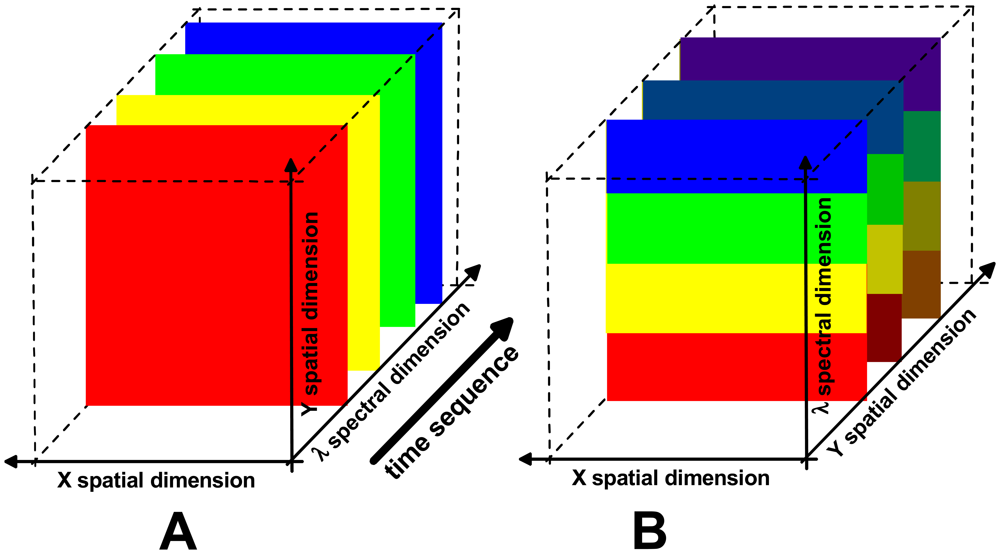
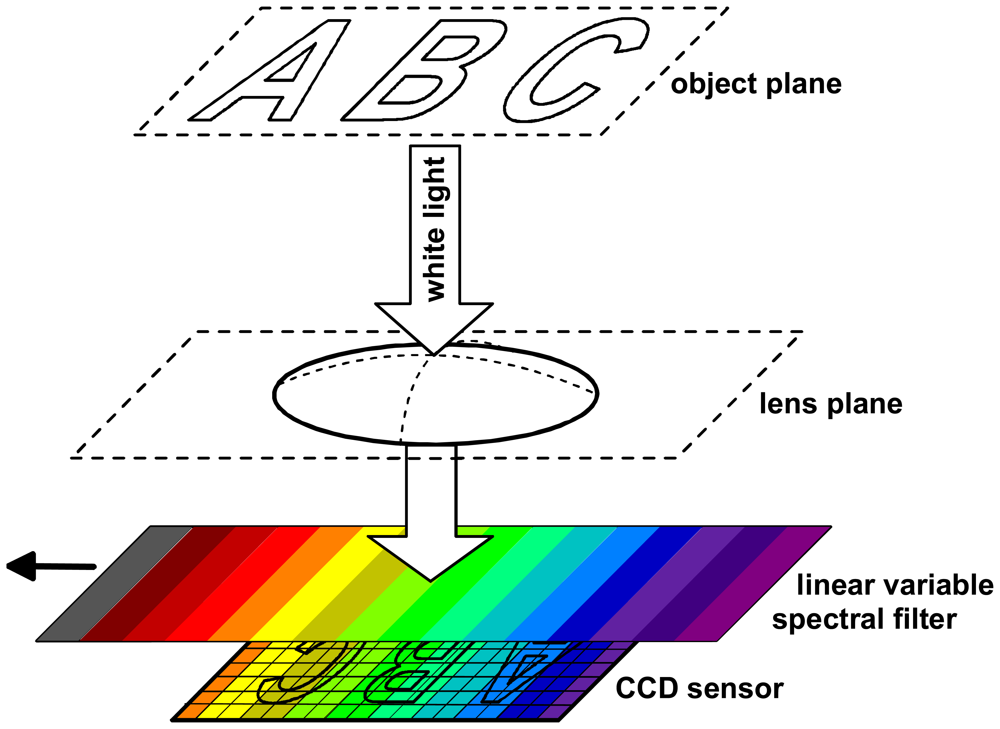
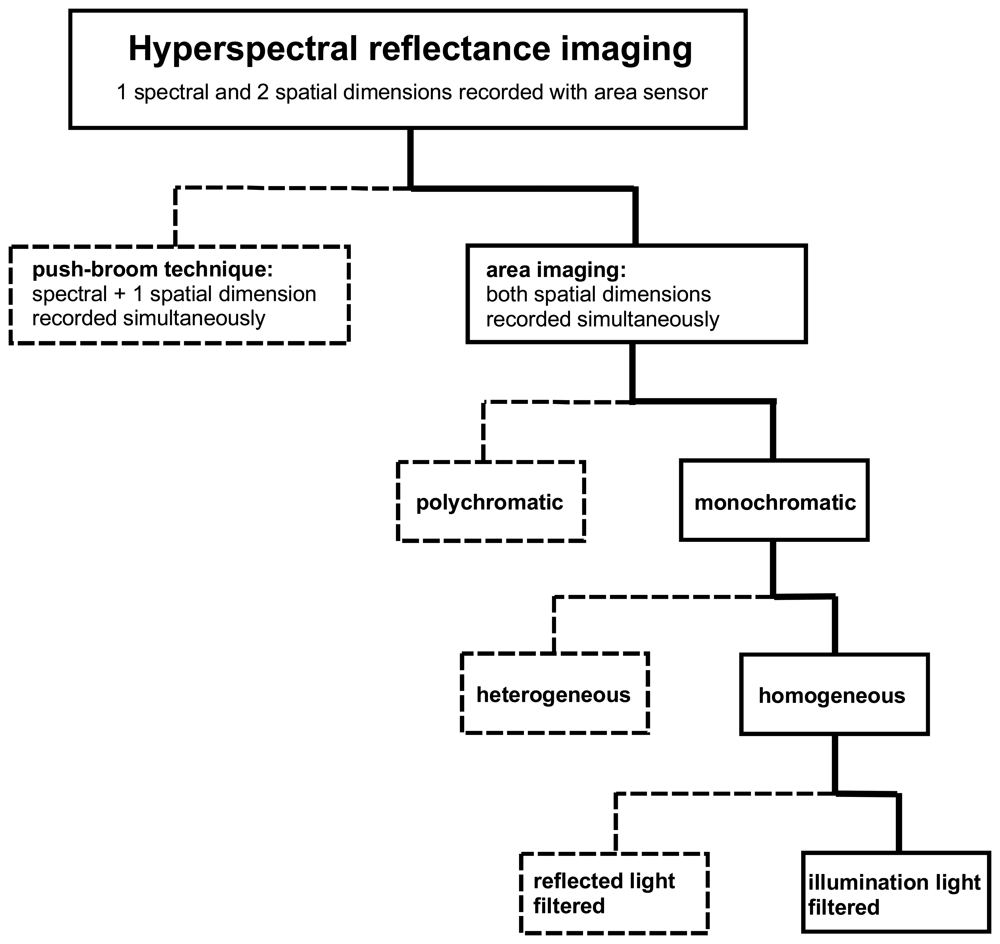
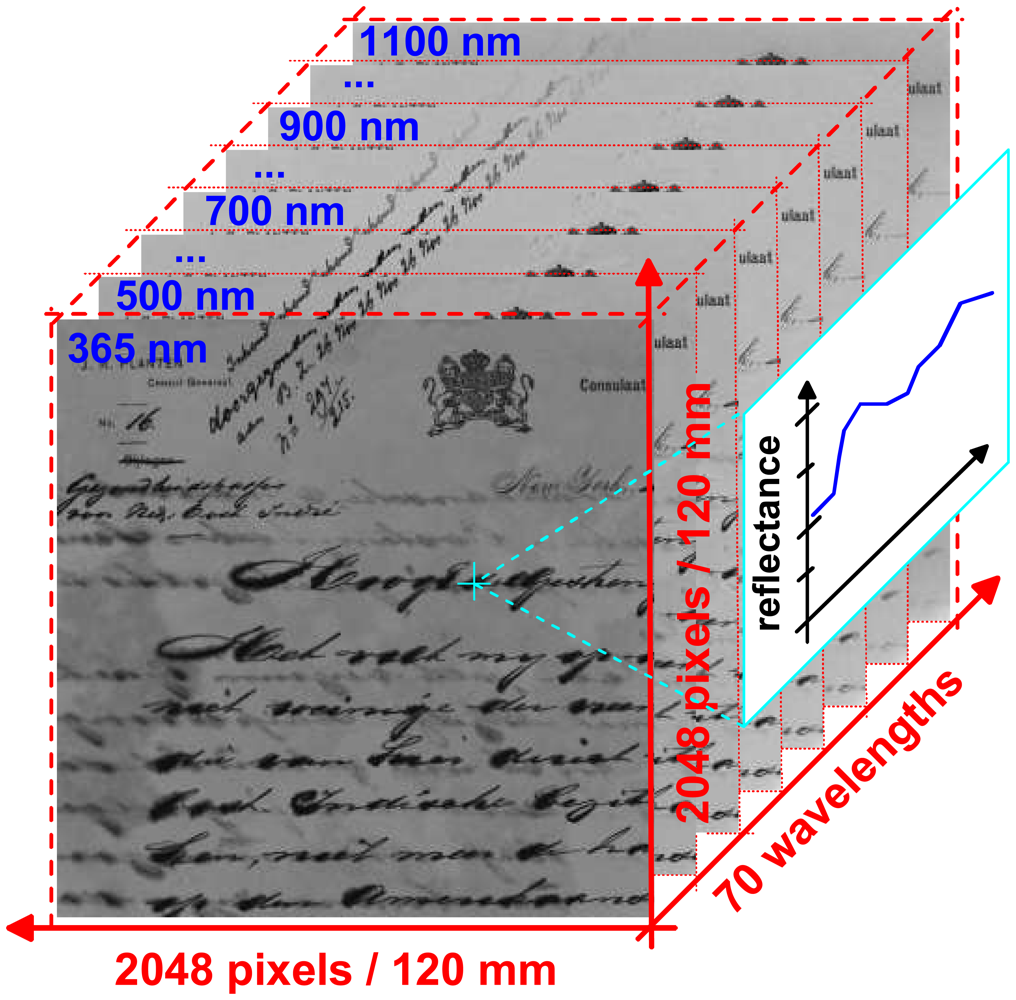
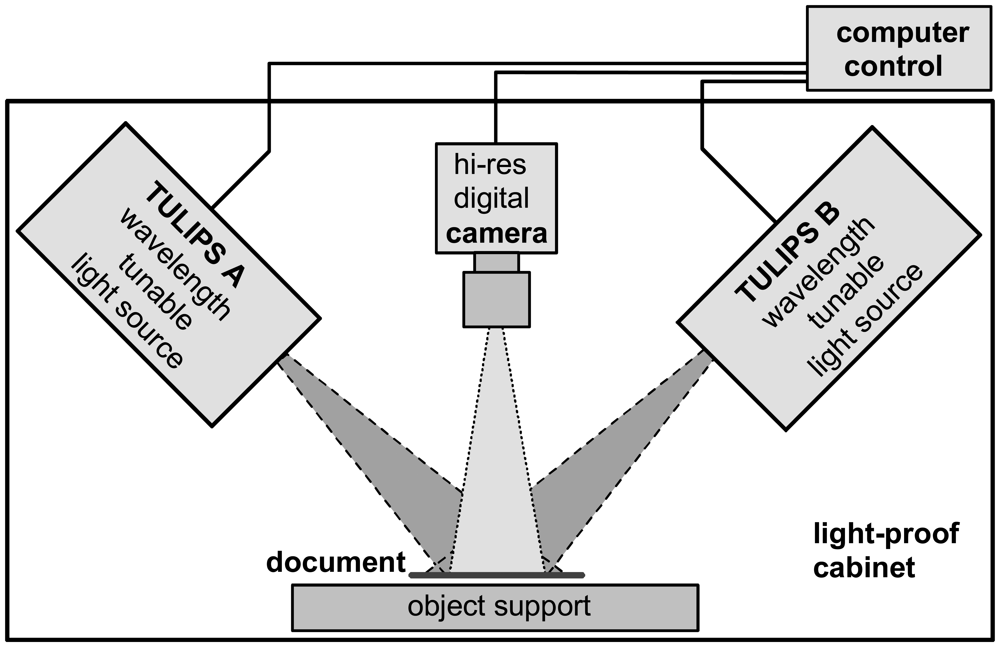
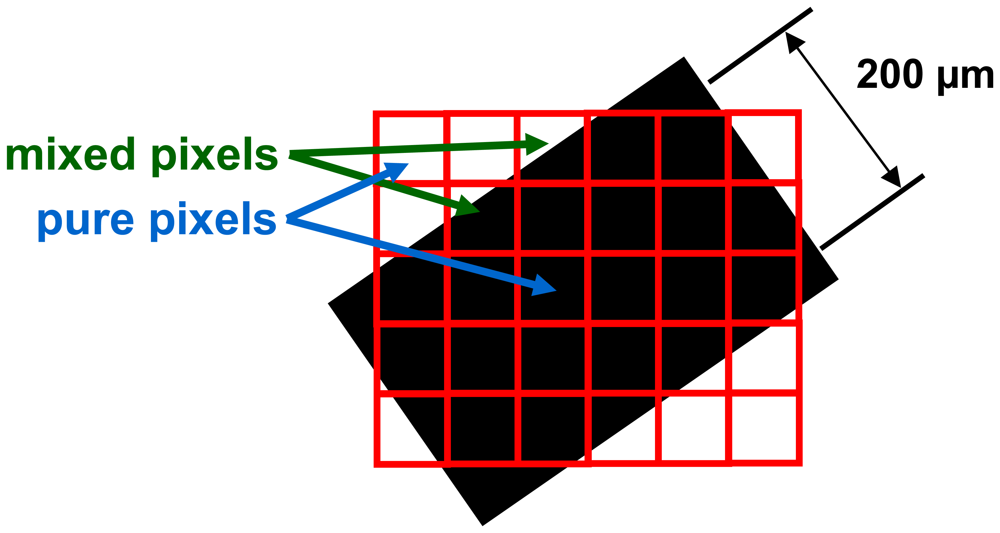


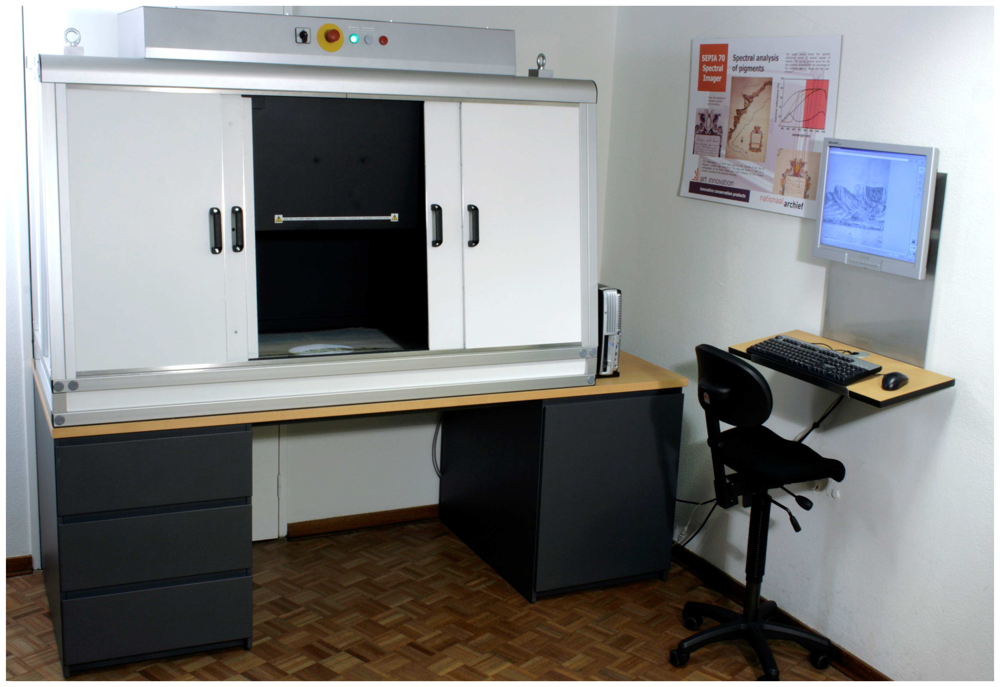
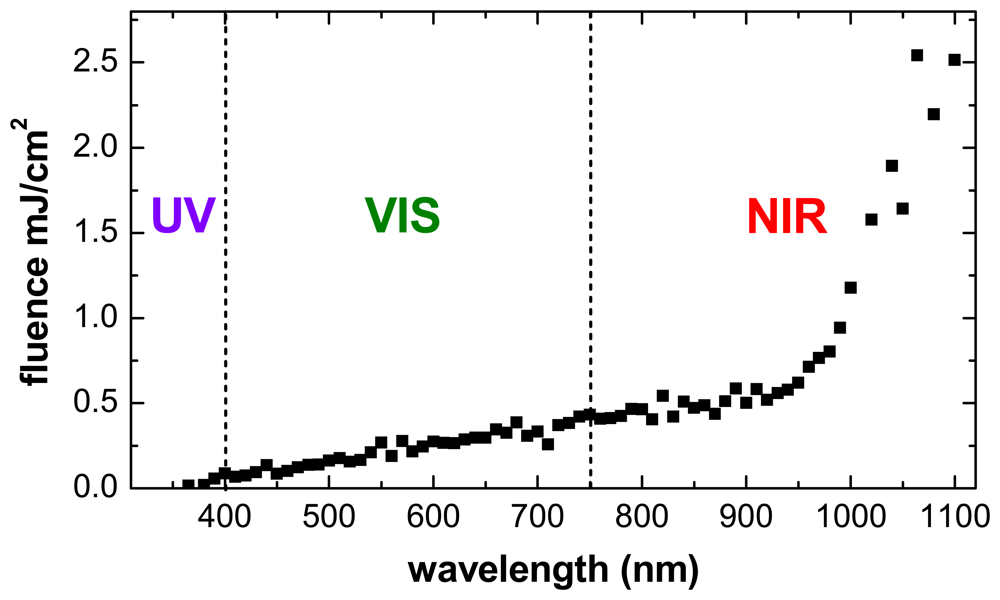
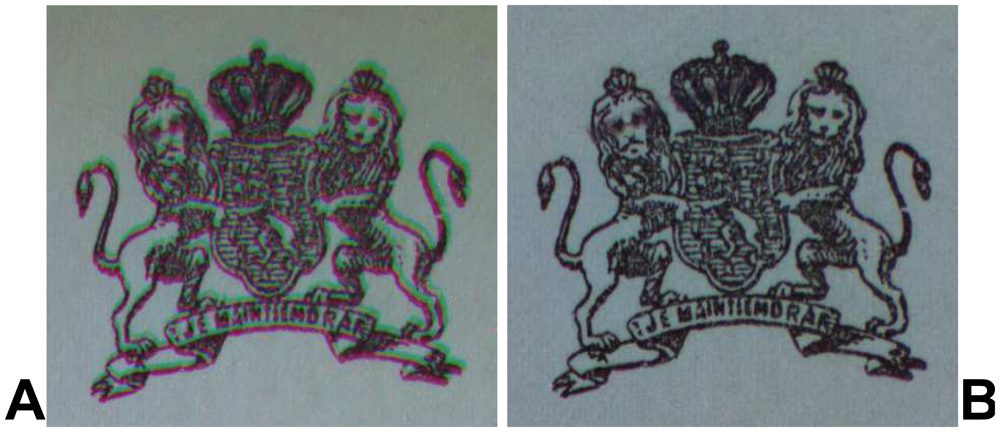

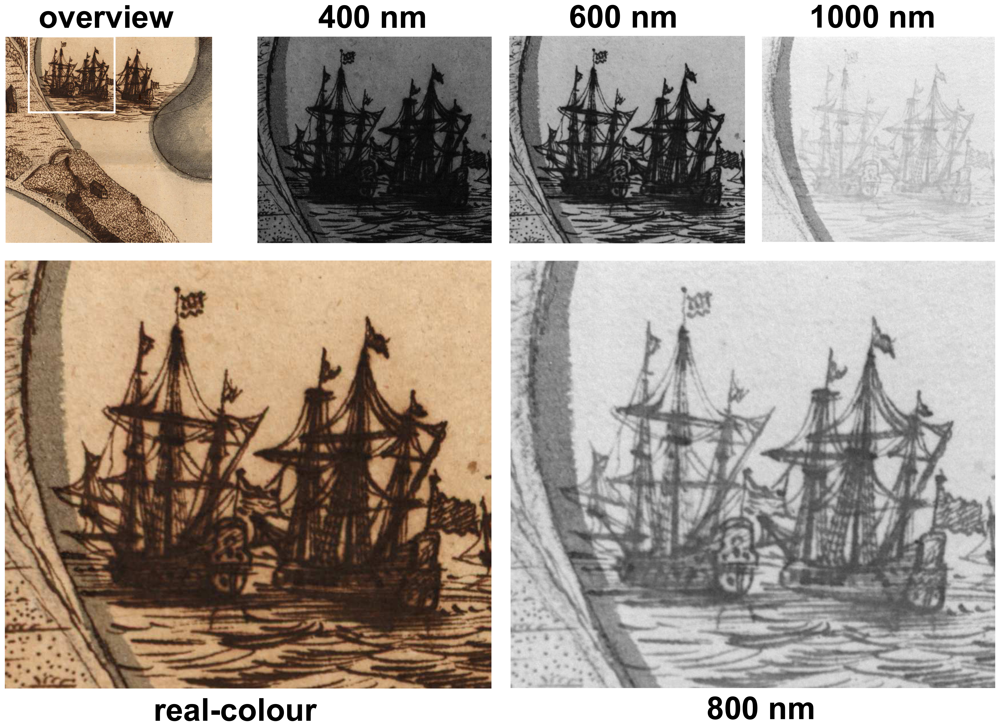

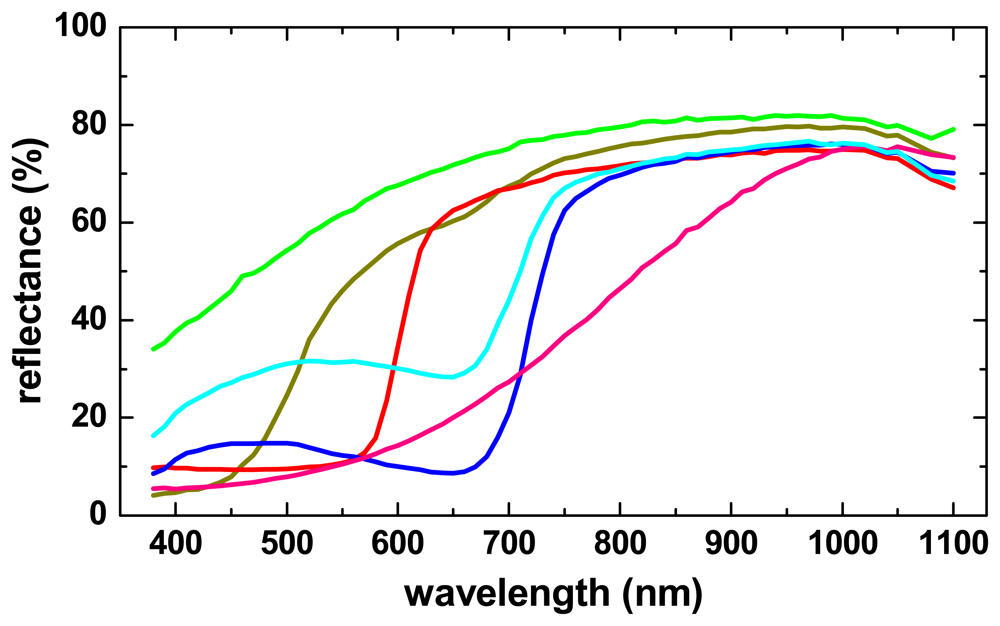


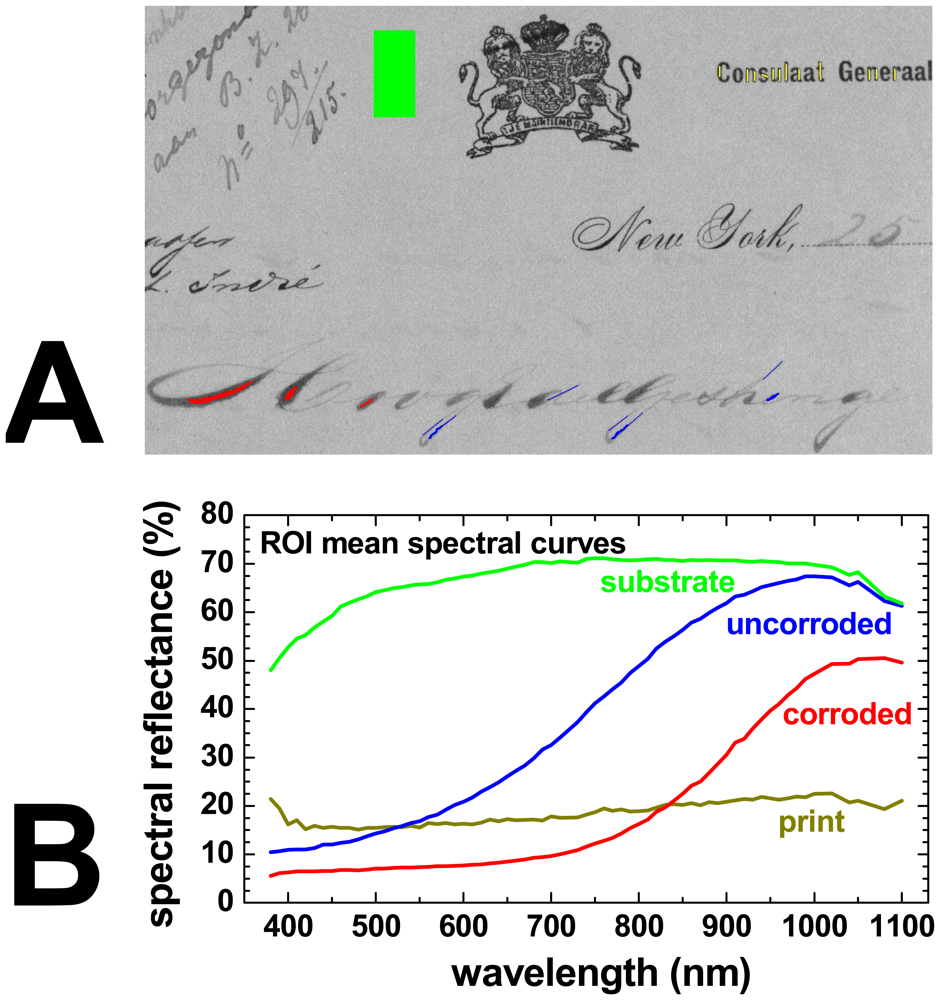
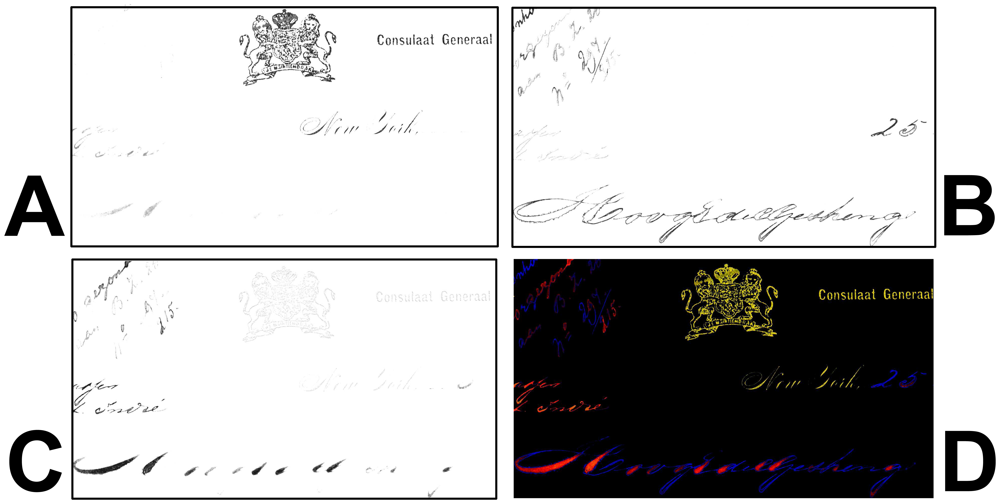
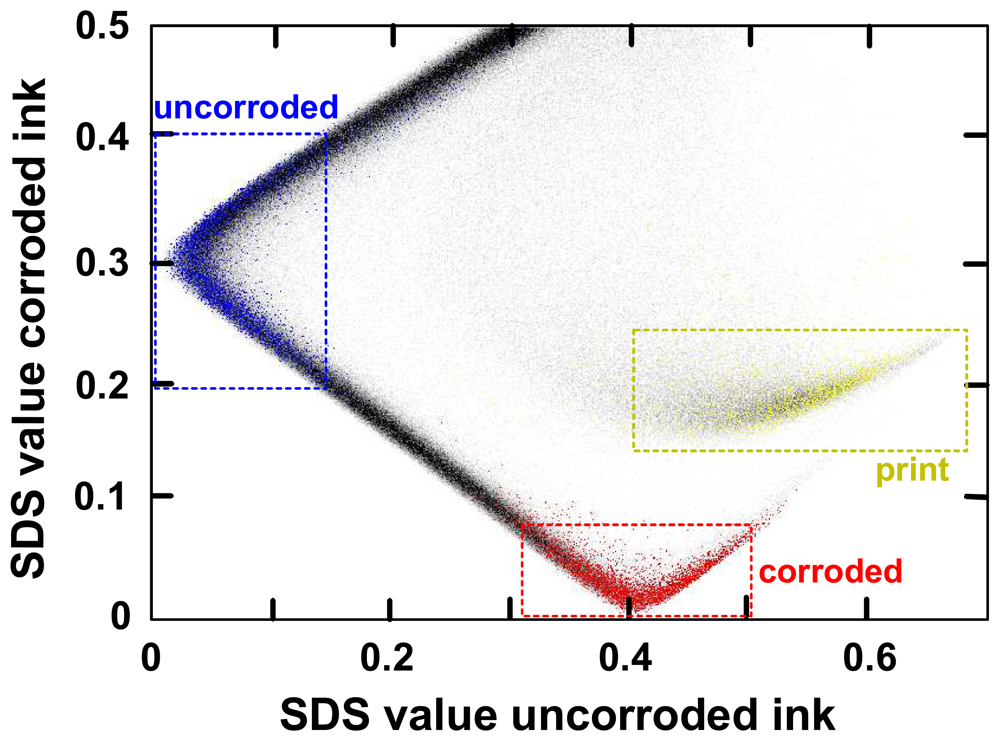
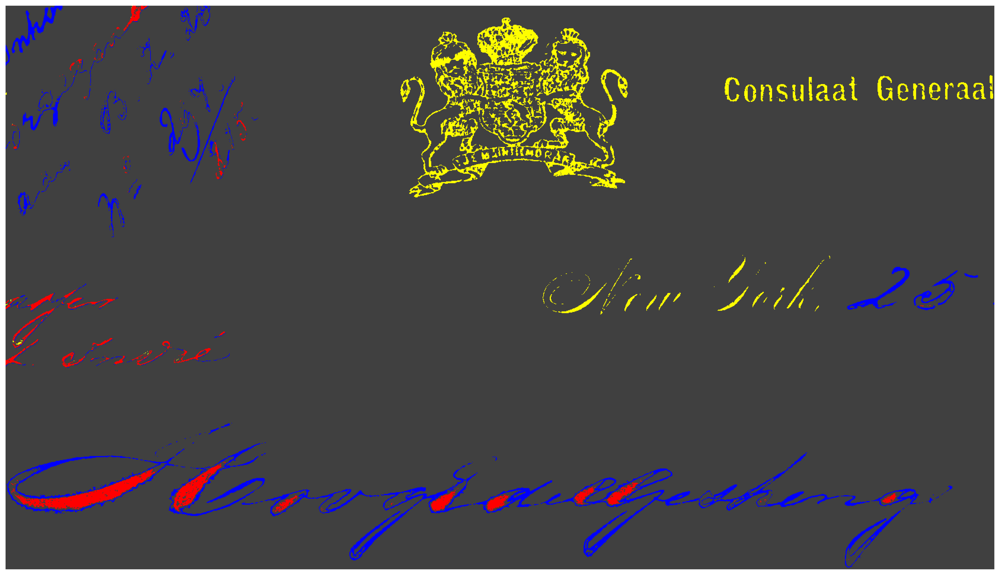
| Calibrated reflectance spectral images | 70 |
| Spectral range | 365 nm to 1100 nm (near-UV, VIS, near-IR) |
| Spectral resolution FWHM | 10 – 16 nm |
| Camera sensor type | Charge-coupled device (CCD) |
| Camera resolution | 2048 × 2048 pixels (4 megapixels) |
| Camera dynamic range | 12 bit |
| Maximum document size | 310 mm × 460 mm |
| Field-of-view (imaged object area) | 120 mm × 120 mm |
| Pixel resolution on object | 60 μm |
| Reflectance standard | White Spectralon© |
| Operation environment | 15 - 30°C, Rh 0 − 80% |
| Output format of spectral images | 16 bit TIFF |
| Physical instrument size B × H × W | 185 cm × 80 cm × 100 cm |
| Spectral range | Fluence during measurement | Fluence portion | Illuminance over time |
|---|---|---|---|
| Ultraviolet (UV) | 0.09 mJ/cm2 | 0.3% | - |
| Visible (VIS) | 8.35 mJ/cm2 | 23.8% | 730 lx·h |
| Near-infrared (NIR) | 26.66 mJ/cm2 | 75.9% | - |
| symbol | description |
|---|---|
| R(x,λ) | Spectral reflectance at wavelength λ for the location x of the object, which corresponds to pixel coordinate px |
| R(px,λ) | |
| Pr(x,λ) | Light power at the wavelength λ reflected from unit area at location x of the object, which corresponds to pixel coordinate px. The subscripts S and T refer to the object and standard target, respectively. |
| Pr(px,λ) | |
| Pi(x,λ) | Light power at the wavelength λ illuminating a unit area at location x of the object, which corresponds to pixel coordinate px. The subscripts S and T refer to the object and standard target, respectively. |
| Pi(px,λ) | |
| C(λ) | Conversion factor between light energy at wavelength λ captured by the CCD sensor and the resulting pixel values |
| tS | Exposure time used for the spectral image of the standard reflectance target |
| tT | Exposure time used for the spectral image of the object |
| T(px, λ,tT) | Value at pixel coordinate px of spectral object image taken with exposure time tT at wavelength λ |
| S(px, λ,tS) | Value at pixel coordinate px of standard reflectance target taken with exposure time tS at wavelength λ |
| D(px,tT) | Value at pixel coordinate px of a dark frame taken with exposure time tT |
| D(px,tS) | Value at pixel coordinate px of a dark frame taken with exposure time tS |
| s(λ) | Known spectral reflectance value of the spatially homogeneous standard reflectance target |
© 2008 by the authors; licensee Molecular Diversity Preservation International, Basel, Switzerland. This article is an open-access article distributed under the terms and conditions of the Creative Commons Attribution license (http://creativecommons.org/licenses/by/3.0/).
Share and Cite
Klein, M.E.; Aalderink, B.J.; Padoan, R.; De Bruin, G.; Steemers, T.A.G. Quantitative Hyperspectral Reflectance Imaging. Sensors 2008, 8, 5576-5618. https://doi.org/10.3390/s8095576
Klein ME, Aalderink BJ, Padoan R, De Bruin G, Steemers TAG. Quantitative Hyperspectral Reflectance Imaging. Sensors. 2008; 8(9):5576-5618. https://doi.org/10.3390/s8095576
Chicago/Turabian StyleKlein, Marvin E., Bernard J. Aalderink, Roberto Padoan, Gerrit De Bruin, and Ted A.G. Steemers. 2008. "Quantitative Hyperspectral Reflectance Imaging" Sensors 8, no. 9: 5576-5618. https://doi.org/10.3390/s8095576




